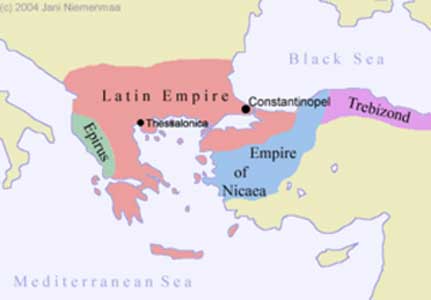.

The Latin Empire, Empire of Nicaea, Empire of Trebizond and the Despotate of Epirus. The borders are very uncertain.
In 1204 the knights of the Fourth Crusade set up a Crusader state known as the Latin Empire, or Romania, based in Constantinople, after sacking that city. They intended it to be a Roman Catholic successor to the Byzantine Empire. Baldwin IX, Count of Flanders, was crowned the first emperor on May 16, 1204.
The Latin name of the emperor was Imperator Romaniae, or Emperor of Romania. This name had nothing to do with the modern country by that name; rather, it is the Latin form of the title of the Byzantine Emperor, whom the Latin Emperor hoped to replace. The Byzantine Empire was never called that at the time, and the Emperor's title was Basileos Rhomaion, or Emperor of the Romans. This had the curious effect of creating three Roman Empires in Europe at the same time, the other being the Holy Roman Empire.
The Latin Empire laid claim to all of the lands controlled by the Byzantine Empire at the time Constantinople was conquered, and did exert control over areas of Greece (the Crusader States: the Kingdom of Thessalonica, the Principality of Achaea, and the Duchy of Athens). However, much of the territory remained in the hands of rival states led by aristocrats of the former empire, such as the Despotate of Epirus, the Empire of Nicaea, and the Empire of Trebizond. Although the relatives of Baldwin, Count of Flanders struggled for many years for their domain, the Latin Empire ended on July 25, 1261 when Michael VIII Palaeologus recaptured Constantinople, deposing the last Latin Emperor, Baldwin II.
For about a century thereafter, the heirs of Baldwin II continued to use the title of Emperor of Constantinople, and were seen as theoretical overlords by the various remaining Latin states in the Aegean.
Latin Emperors of Constantinople, 1204–1261
- Baldwin I (1204– - 1205)
- Henry of Flanders (1206 - 1216)
- Peter of Courtenay (1217)
- Yolanda of Flanders (1217– - 1219)
- Robert of Courtenay (1221– - 1228)
- John of Brienne, regent (1228 - 1237)
- Baldwin II (1228 - 1261), died 1273
Titular Latin Emperors of Constantinople, 1261–1383
- Emperor Baldwin II 1261– - 1273
- Philip of Courtenay 1273– - 1283
- Catherine de Courtenay 1283 - 1308
- Charles of Valois (her husband) 1302 - 1308
- Catherine de Valois 1308– - 1346
- Philip I of Taranto (her husband) 1313 - 1332
- Robert of Taranto 1346– - 1364
- Philip II of Taranto 1364– - 1373
- James of Baux 1373– - 1383
James willed his titular claims to Duke Louis I of Anjou, also claimant to the throne of Naples, but Louis and his descendants never used the title.
Jonathan Phillips, The Fourth Crusade and the Sack of Constantinople, Pimlico, 2005. ISBN 1844130800
John Julius Norwich, A Short History of Byzantium ,Vintage; Reprint edition 1998, ISBN: 0679772693
| Ancient Greece
Science, Technology , Medicine , Warfare, , Biographies , Life , Cities/Places/Maps , Arts , Literature , Philosophy ,Olympics, Mythology , History , Images Medieval Greece / Byzantine Empire Science, Technology, Arts, , Warfare , Literature, Biographies, Icons, History Modern Greece Cities, Islands, Regions, Fauna/Flora ,Biographies , History , Warfare, Science/Technology, Literature, Music , Arts , Film/Actors , Sport , Fashion --- |
Retrieved from "http://en.wikipedia.org"
All text is available under the terms of the GNU Free Documentation License

